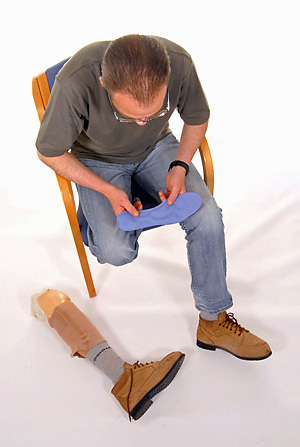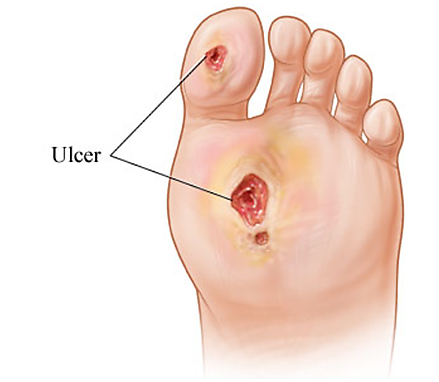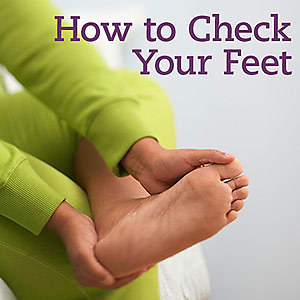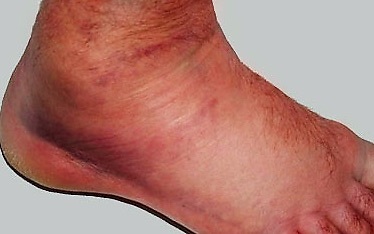Health & Well-being21st July 2015
Diabetes-related amputations are 85% avoidable
Knowledge and management of the personal risks could reduce the number of lower limb amputations

Working with someone who has Type 2 diabetes recently, I have been shocked to learn about some of the risks involved with the condition. Despite several Deaf friends being diabetic and talking to them openly about it over many years, the information gleaned recently is all new to me. That made me wonder whether some of this life threatening/life saving information is readily available in the deaf community. I feared not.
 When I was sent some information last week about lower limb amputations, I was shocked to learn that knowledge and acting on that knowledge could prevent a lot of them. A shocking bit of information! But this is a small problem right? Wrong! In the last week alone, there were over 30,000 lower limb amputations caused by diabetes worldwide – equivalent to one every twenty seconds!
When I was sent some information last week about lower limb amputations, I was shocked to learn that knowledge and acting on that knowledge could prevent a lot of them. A shocking bit of information! But this is a small problem right? Wrong! In the last week alone, there were over 30,000 lower limb amputations caused by diabetes worldwide – equivalent to one every twenty seconds!
London-based podiatrist Peter Allton says that 85% of these could be avoided. Critical to this is teaching people who have diabetes to manage their condition effectively. The problem is so great Peter felt compelled to write a book about the importance of foot health in people living with diabetes called, ‘Undefeeted by Diabetes’. As someone who lives with Type 2 diabetes, Peter understands that education is vital to managing the condition.
 “If someone with diabetes develops a foot ulcer, their survival chances are worse than those of someone with prostate or breast cancer. A person with a foot ulcer has an 80% chance of not surviving five years, compared to 18% and 40% respectively for a person with breast or prostate cancer. Diabetes can be extremely difficult to live with if you don’t have the right information and strategies in place.”
“If someone with diabetes develops a foot ulcer, their survival chances are worse than those of someone with prostate or breast cancer. A person with a foot ulcer has an 80% chance of not surviving five years, compared to 18% and 40% respectively for a person with breast or prostate cancer. Diabetes can be extremely difficult to live with if you don’t have the right information and strategies in place.”
‘Undefeeted by Diabetes’ focuses on helping people with diabetes live in what Peter calls the ‘diabetic sweet spot’ – the safest possible position for them. The ‘sweet spot’ refers to a combination of knowledge and awareness of their personal risk and taking appropriate action that helps them to live full and healthy lives. The book is aimed at those with diabetes, those at risk of developing diabetes, their family members, friends and carers. The ‘Undefeeted’ campaign has drawn praise from leaders in the global diabetes and podiatry communities.
 Dr David G Armstrong, Professor of Surgery at the University of Arizona, USA and Director at the Southern Arizona Limb Salvage Alliance (SALSA): “Every twenty seconds, somewhere in the world, an amputation is performed on a person with diabetes. The good news is that nearly all of these are ultimately avoidable.”
Dr David G Armstrong, Professor of Surgery at the University of Arizona, USA and Director at the Southern Arizona Limb Salvage Alliance (SALSA): “Every twenty seconds, somewhere in the world, an amputation is performed on a person with diabetes. The good news is that nearly all of these are ultimately avoidable.”
Posted by David Gibson on Tuesday, 4 August 2015
A video clip by David Gibson via Facebook - thank you for sharing.
Dr Gerry Rayman, Lead Diabetologist at Ipswich Hospital and Medical Advisor to Diabetes UK: “Peter has done a fantastic job. Undefeeted by Diabetes is about empowering people with diabetes to understand and take control of their condition. Peter has drawn on his experience as a podiatrist with patients with diabetes and tried to understand what causes the complications of diabetes and why we, as a profession, have let them down.”
 “We haven’t made them aware of what to do and how to spot the warning signs. We can patch people up but it’s much better to give people the ability to prevent complications themselves.”
“We haven’t made them aware of what to do and how to spot the warning signs. We can patch people up but it’s much better to give people the ability to prevent complications themselves.”
Peter Allton hopes that the Undefeeted campaign can raise awareness of lower limb complications in diabetes: “The number of people who live with the condition but are unaware of the impact it can have on their feet is staggering. Diabetes can play havoc with your feet unless you manage it carefully.”
The following information about foot safety comes for the Diabetes UK Website (www.diabetes.org.uk):
 Top tips for healthy feet
Top tips for healthy feet
• Have a quality foot check by an appropriately trained person at least once a year. You should always take your shoes and socks off so that they can do a proper assessment
• Don’t be self-conscious about your feet
• After the foot check, ask what your risk is of developing foot problems
• If you are at increased risk of foot problems, make sure you have been referred to a foot protection service or specialist podiatrist for expert input
• Check your feet every day - look for any signs of redness, pain, build-up of hard skin or changes in the shape of your feet. Find out more about how to spot foot problems
• Be aware of any loss of feeling in your feet because you may not feel if you hurt your feet
• Ask someone at home to monitor the feeling in your feet by doing the quick, easy Touch the toes test. This can be done between appointments and if there are any changes go to your GP. The Touch the Toes test is not a substitute for the annual foot review
• Look after your toenails
• Do not use corn-removing plasters or blades as these can damage healthy skin
• Use moisturising cream every day and wear well-fitting shoes that protect and support your feet
• Always examine the inside of your shoes for sharp objects or stones before putting them on and replace ruffled innersole linings. Avoid socks, stockings or tights with wrinkles or prominent seams
• Garters and stockings or socks with elastic tops should also be avoided because they may restrict the circulation. Never wear socks with darned areas or holes
• Know who to call at the first sign of any new foot problem.
 Steps you can take to prevent problems happening
Steps you can take to prevent problems happening
• If you smoke, get support to help you stop because smoking affects blood circulation and so increases your risk of developing serious foot problems
• Keep good control of your blood glucose, blood pressure and cholesterol levels
• Eat a healthy diet that is low in saturated fat, sugar and salt, and high in fruit and vegetables
• Make sure you attend your annual foot check
• Know your risk of developing foot problems and if you have been referred to a foot specialist for expert advice
• Attend all your appointments
• Follow our top tips for healthy feet
• Make sure that your socks and shoes are comfortable and fit well
• If you are able to, take regular physical activity, for example a brisk walk each day
• Contact your GP or diabetes team if you have any concerns about your feet - don’t wait until your annual foot review
 FEET
FEET
What is a foot attack?
If you have been told you are at risk of developing foot problems, you could have a foot attack. It’s important that you know how to spot a foot attack and what you need to do at home to keep your feet problem-free.
A foot attack is an injury to the foot (or feet) of someone with diabetes who has reduced feeling or reduced blood circulation to their feet. It is a medical emergency that needs attention. It often starts as a small break in the skin and can quickly develop into a foot ulcer. It can start from something as small as a blister that forms because you didn’t feel your shoe rubbing, a small cut or wound from standing on a sharp object. You may not have felt the pain because you have lost sensation in your feet.
 What are the danger signs?
What are the danger signs?
• Is your foot red, warm or swollen?
• Is there a break in the skin or any discharge (or oozing) onto your socks or stockings?
• Do you feel unwell?
Remember you may not experience pain even with a visible wound. If your sight is not good make sure someone else looks at your feet every day.
What to do if you’re having a foot attack
Contact your GP or Foot Protection Service immediately. If they are not available and there is no sign of healing after one day, go to your nearest out-of-hours healthcare service or your A&E department.
Article by SLFirst Team
posted in Deaf Lifestyle / Health & Well-being
21st July 2015





